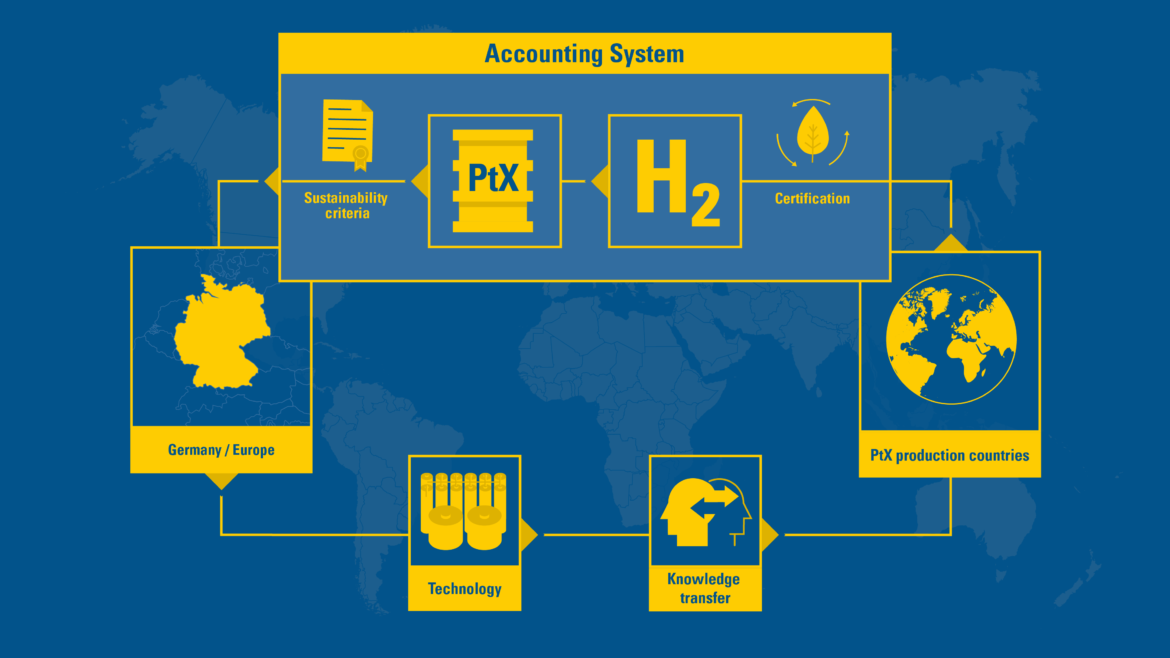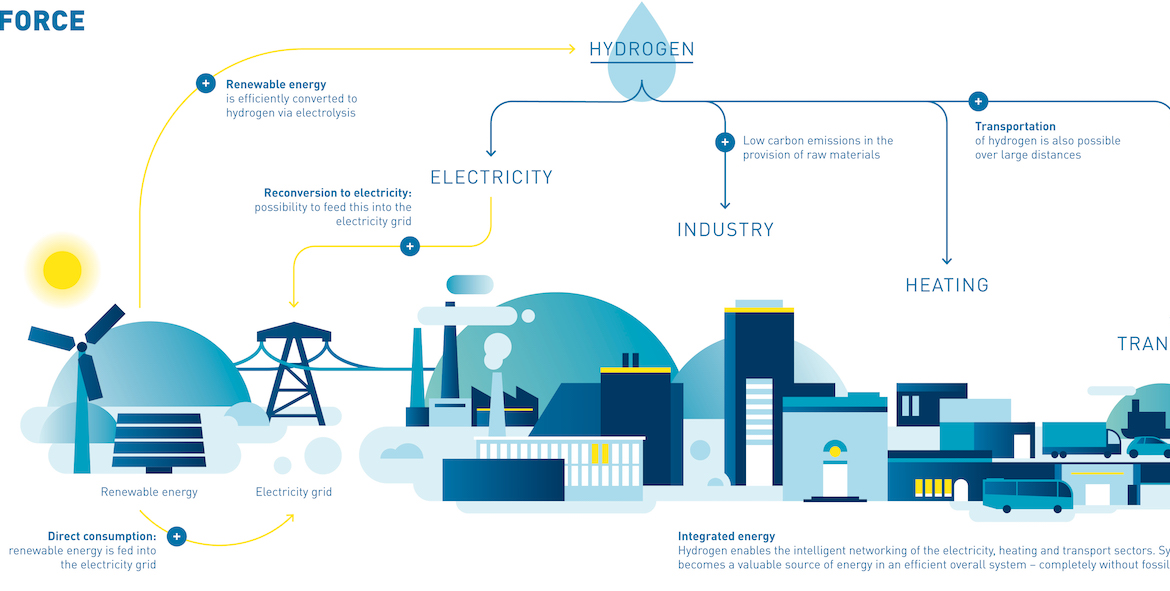HyLand
The federal government’s climate protection goals are clearly defined: CO2 reductions of up to 95 per cent by the year 2050. This requires a continuously rising share of renewable energies as well as sector integration. Green hydrogen will play an instrumental role here.
Municipalities and regions are implementing environmental and transport concepts on a local level. They have access to numerous regulatory instruments in the transport planning and management area. They mark areas for the development of infrastructure for alternative fuels and together with municipal companies, have fleets and car pools at their disposal.
Depending on their individual starting point, subsidising hydrogen regions in Germany should motivate municipalities and regions in a targeted way to develop their initial ideas for integrated concepts, put their plans into more concrete terms and work out these plans or implement them with the aid of the federal government. The varying levels of knowledge and experience in the different regions is taken into account in the funding process, as all regions should have the opportunity to become hydrogen regions.
Funding for regions and municipalities ranges therefore from support for awareness campaigns or the initial organisation of actors’ involvement (HyStarter), creating integrated concepts and in-depth analyses (HyExperts), to taking the step of being able to procure actual applications and implementing those concepts (HyPerformer).
-
- The following regions were chosen: Region Kiel, Rügen-Stralsund, Landkreis Schaumburg, Lausitz, Weimar, Landkreis Marburg, Neustadt an der Waldnaab, Reutlingen, Allgäu
- Regions and/or municipalities will each be advised for 1 year both in terms of content and organisation. Generation of a landscape of actors (politics, municipal companies, industry, trade, society) and the joint development of initial concepts on the topic of hydrogen and fuel cells based on renewable energy in transport, but also in the areas of heat, electricity and storage systems.
- A consortium was commissioned to implement the project: Spilett, Choice, Becker-Büttner-Held Consulting, EE ENERGY ENGINEERS and Reiner-Lemoine-Institut.
- More information on: hy-starter.de
- The following regions were chosen: City of Brake, Landkreis Emsland, City of Essen, City of Frankfurt am Main, City of Fulda, City of Ingolstadt, Kreis Lippe, Landkreis Oberallgäu, Landkreis Osterholz, Kreis Recklinghausen, Bundesland Saarland, City of Ulm, Landkreis Wunsiedel im Fichtelgebirge
- 300.000 EUR prize money for the creation and calculation of concrete project ideas for hydrogen concepts for each winning region
- The following regions were chosen: Region Landshut (including Landkreis München and Ebersberg), Metropolitan Region North West (Oldenburg and Sourroundings), Metropolitan region Rhein-Neckar
- 20 Mio. EUR in the form of investment grants to implement regional concepts with hydrogen and fuel cellsfor each winning region
- The total project volume of the three HyPerformer is 195 Mio. EUR in total.
Sustainable Hydrogen Production
Large quantities of green hydrogen and derived products based on it (via Power-to-X, or PtX for short) are needed for comprehensive decarbonization of all sectors. Due to the limited possibilities in Germany to build PtX plants, the establishment of international production facilities and corresponding transport infrastructures is necessary.
For an international hydrogen economy, the development of uniform sustainability criteria and reliable verification methods is necessary, to
- accelerate the international market ramp-up of hydrogen technologies,
- ensure climate-friendly hydrogen production,
- increase the acceptance of hydrogen technologies and to
- enable efficient processing of trading transactions.
NOW deals with this subject area in various contexts and accompanies ongoing political and civil society processes at national, European and international level.
For the supply of large quantities of sustainably produced hydrogen and its PtX derivatives (e.g. synthetic fuels or chemicals) it is essential to develop global locations with high potentials for the expansion of renewable energies. Only the worldwide construction of hydrogen production plants at locations with favorable framework conditions (e.g. North Africa and the Gulf region) will enable a cross-sectoral, broad use of green hydrogen.
On the one hand, an international hydrogen economy can enable the achievement of national and international climate protection targets. On the other hand, it offers completely new potential for locations worldwide: For example, regions that are heavily dependent on the import of fuels or fertilizers can become more independent by producing green hydrogen or PtX products locally. Surplus production volumes could be exported. If the sustainable use and participation of local partners is ensured, this can also contribute to the prosperity and stabilization of regions that have been marked by conflict up to now. First global partnerships for an international hydrogen economy have already been established. The expansion of further international cooperation is an important step for global climate protection.
For a sustainable production of hydrogen and PtX products, different requirements have to be met in the production process. The focus here is on supplying the production plants with additional renewable electricity in order to avoid the emission of climate-damaging emissions during the production process itself. In addition, the use of other resources, such as water and possibly carbon, plays an important role in assessing the environmental sustainability of hydrogen and PtX products. For a holistic view, the economic and social impacts of large infrastructure projects for hydrogen production must also be taken into account.
So far, there are no international standards for the sustainable production of hydrogen. For a global market ramp-up of hydrogen technologies and an international sustainable hydrogen economy it is therefore now necessary to establish appropriate balancing and certification systems. This is the only way for traders and users to understand transparently, efficiently and reliably how sustainable hydrogen really is.
The development of sustainability requirements and verification procedures can build on the experience of similar systems for biofuels and electricity from renewable energies. Experience has shown that the establishment of global certification systems with transparent and reliable proof of complex product properties is also possible for international supply chains.
At EU level, the CertifHy project has already created the first certification system for climate-friendly hydrogen at European level. The European Renewable Energy Directive stipulates the establishment of corresponding verification systems for all member states by 2021. At the same time, the European Commission will set requirements for the production of hydrogen and PtX products used in the transport sector by the end of 2021.
At the same time, the future development of the European gas market is being discussed at EU level within the Madrid Forum – here, too, hydrogen plays an important role.
The challenge is to create a consistent system of adequate minimum sustainability standards that is globally connectable and can also be applied beyond the EU. To achieve this, political institutions have to cooperate closely with each other as well as with industry, science and civil society – and in particular involve actors from potential producer countries. Only in this way can requirements be implemented uniformly and the relevance and acceptance of a green hydrogen economy be strengthened.


